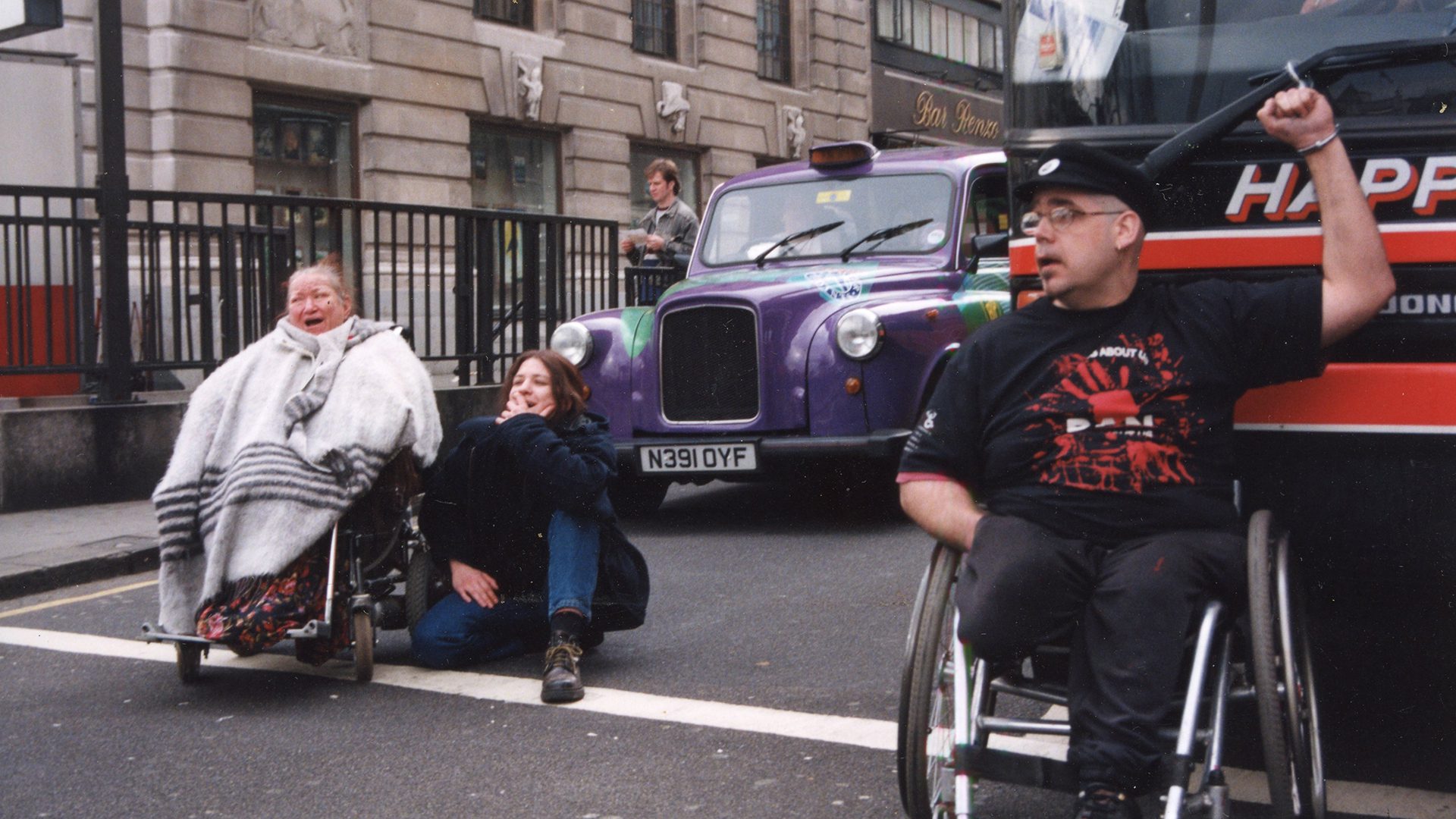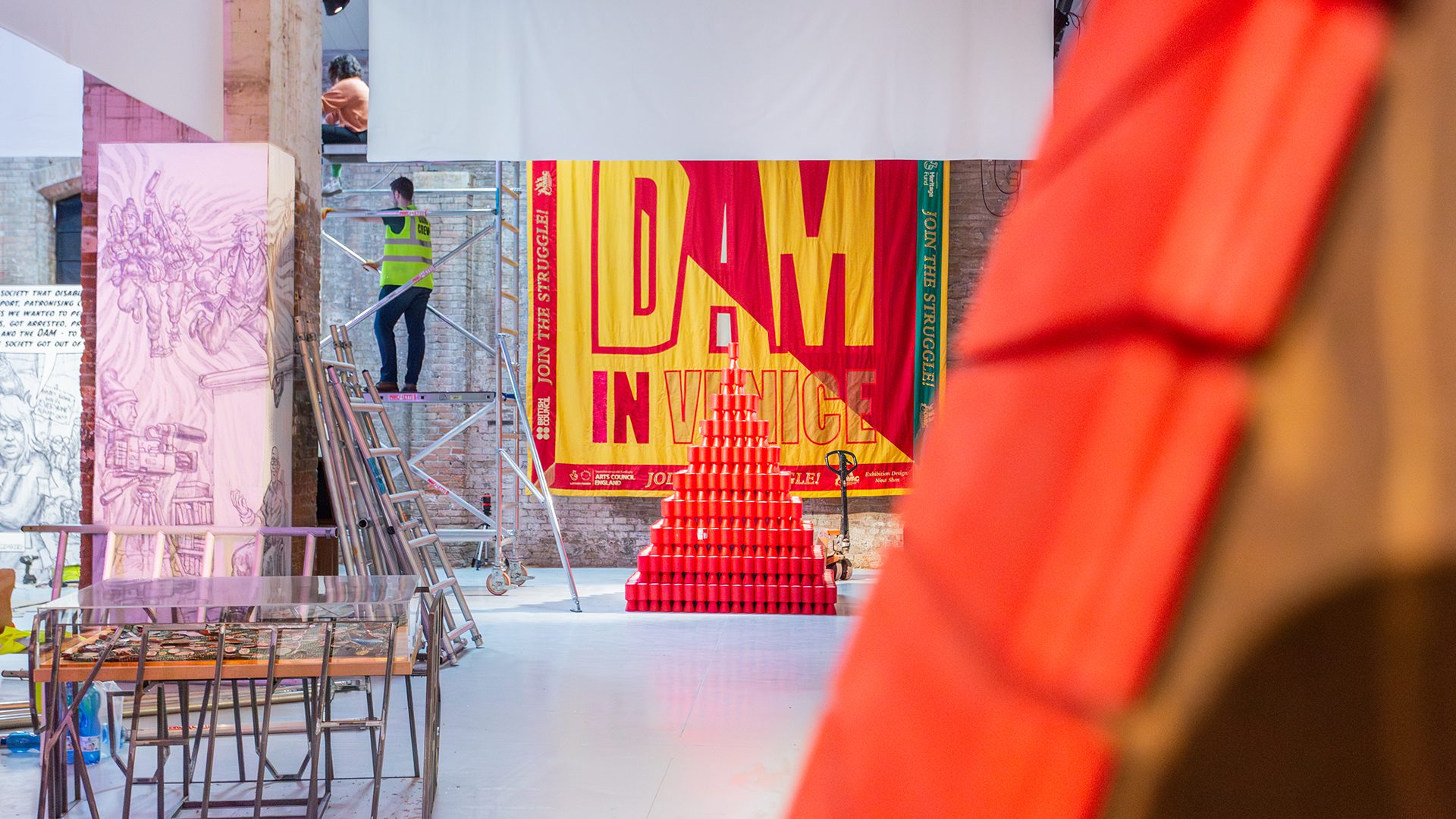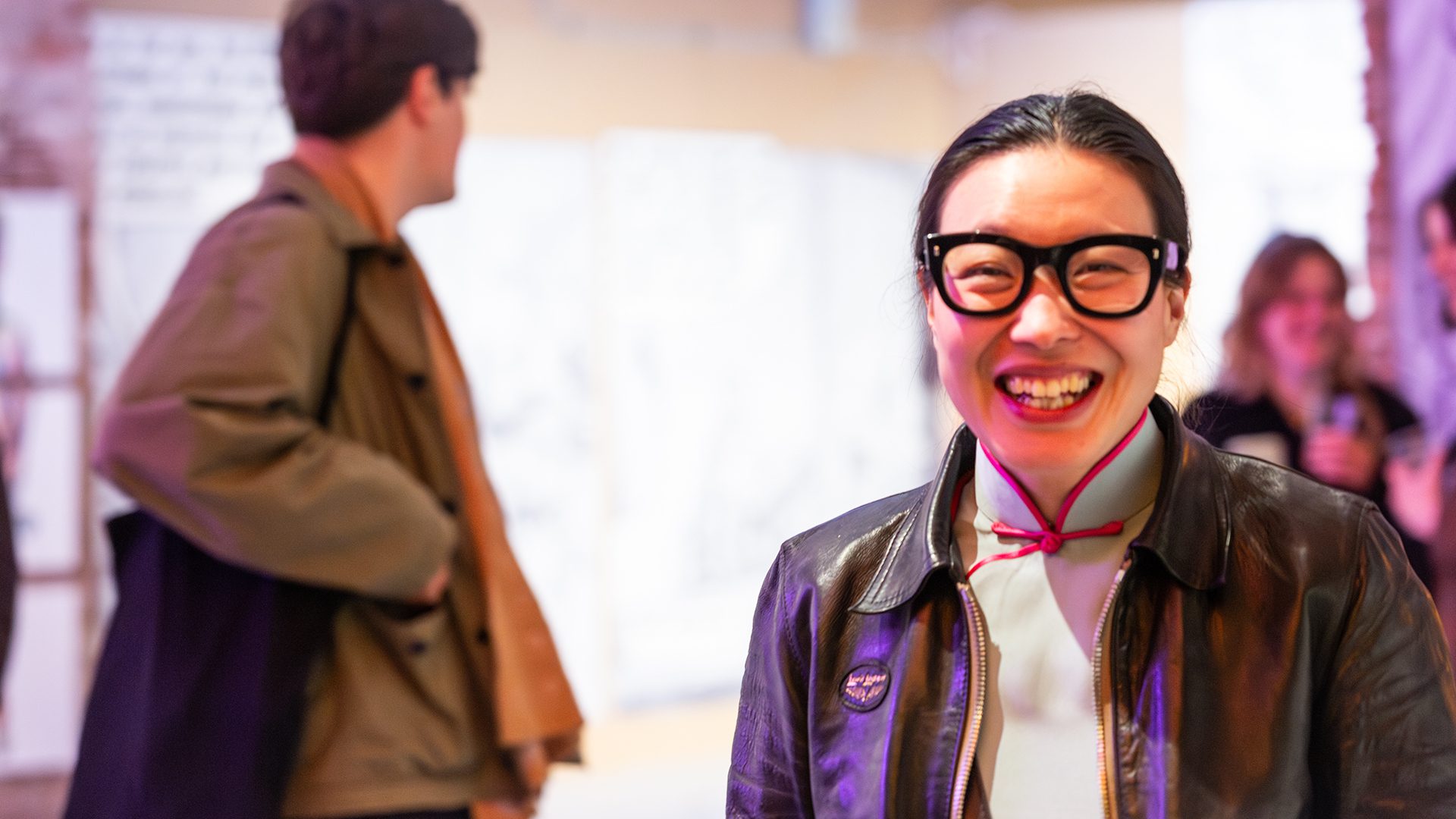HOW I DESIGNED THE DAM IN VENICE – #1
Artist blog series by Nina Shen
In early 2023, CT20’s director Nina Shen was invited by the activist-curator David Hevey to work out how to put on a show in Venice – CRIP ARTE SPAZIO: The DAM in Venice – which showcases for the first time, on a large scale and at an international platform the UK’s Disability Arts Movement, so that people can experience the ‘passion, humour, burlesque, and rights-demanding energy of the DAM’.
In a series of artist blogs, Nina describes her journey with DAM and how she and an amazing team of talented people put on this ambitious show in Venice.
‘The mood of the design: what we want people to feel, think, and do’
In early 2023, I was invited by the activist-curator David Hevey to work out how to put on a show in Venice – CRIP ARTE SPAZIO: The DAM in Venice – which showcases for the first time, on a large scale and at an international platform the UK’s Disability Arts Movement, so that the audience can experience the ‘passion, humour, burlesque, and rights-demanding energy of the DAM’.
‘And arriving at the conclusion that the DAM is the centre of the show – but how?’
The Disability Arts Movement (or DAM) overlapped with the Disability Rights Movement, it was the visible part of the fight for rights. The DAM was not an organised movement, but individual artists who made disability a political issue at the centre of their art. Artists spanned different generations, and worked across different media addressing a diverse range of crip-related issues.
So prior to ‘CRIP ARTE SPAZIO’, there wasn’t much visual coherence to the movement nor were there any previous attempts to define it. It soon became clear to us that we had to find a new way to communicate the movement, which is the centre of the show. So from being a curatorial consultant I quickly took on the challenge of being the exhibition designer. My immediate task was to come up with a strategy to make the works coherent, which involved inventing a necessary new aesthetic for the exhibition to communicate the exuberant energy of the movement, relatable by a new international audience in Venice.
‘Then the NDMAC-supported Keith Armstrong archive emerged half way through this process…’
One key challenge of presenting the artworks was the lack of a key signifier to the DAM. Until one day, the curator David brought in a box containing hundreds if not thousands of film negatives, sweat-stained original protest tees from the 1990s, begging/protest boards and a dramatic funeral shroud full of protest badges belonging to the deceased activist, Keith Armstrong. I thought ‘That’s it!’ and this became a major turning and uniting element, allowing the art works to be free because his protest imagery provided the backdrop to the show, and his archive gave us the right anchor and understanding to the DAM. The other thing I learnt about the DAM from David was the sense of humour of the movement – Keith’s work also has great wit amidst the pathos and so it gave the show the light hearted elements, too.
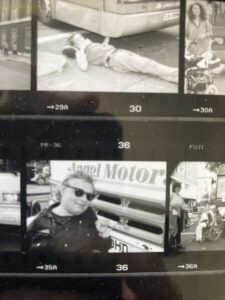
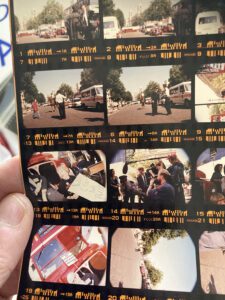
‘So the question became just that – how do you find a way to push that disability rights thing more in-your-face, in ways which do not take away from but elevate the art to its rightful powerful place?’
CRIP ARTE SPAZIO at CREA (CREA Cantieri Del Contemporaneo) looks and feels like it’d always been there. The new props designed for the show, such as the large banners, sliding letter doors, so on and so forth read as if they were part of the original movement. With the exception of the artworks, none of these existed before and the show is a complete invention and a process of active re-interpretation. Achieving this was no mean feat –
Embracing the scale of the architecture – When I visited the site and later made a scaled model of it, it was quite a shock to discover the huge gulf between the enormity of the venue – a raw industrial building that used to be a boatyard on a living dock – and the artworks to be shown, many of which were made within the limitations of the artists’ physicality and space. If they were simply placed within the space as in a more conventional exhibition, the artworks would have been completely lost!
Not the ‘white cube’ – The second convention I tried to dismantle is the sanitised and consecrated space of the white cube galleries, knowing that radical art is so often crushed within these spaces, with too much of their vitality stripped out. On a practical level, it would have been a huge and unnecessary effort and expense to build new walls.
Nor the ‘museum’ approach – The third question was how to make the ‘past’ alive now. The DAM began in Britain in the 1970s and many of the artworks were selected along with the incredible Keith Armstrong photograph collection from the NDMAC archive that later emerged epitomised that period – they had a fixity in time and place. It is easy for us to forget that the fight is on-going. David was a part of the DAM and still is, and like many of the activists that were part of the movement, the exhibition symbolises a universal struggle against social injustice. Heritage content are often ‘preserved’ behind a glass frame, or are in danger of being historicised by didactic approaches that alienate the viewers from the actual events. So we were determined not to lose the agency behind the art and its politics, and we want to make a show about the movement as if it is happening now.
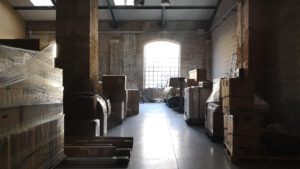
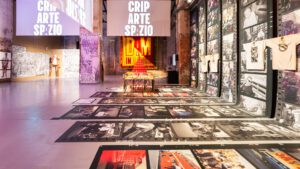
‘Researching the Show – what might be the Crip Urban Language of our show’
Researching for the exhibition, David and I travelled to over 150 exhibitions to see what contemporary exhibiting looked like, from London to Berlin, Kassel, Cologne, to New York and São Paulo.
We found the most vibrant and expressive contemporary artistic language that expresses the way people live now are to be found on the streets and overlooked corners of the urban environment – the graphic intensity and the sophisticated layering of difference cultures and voices, the economy of production and their effectiveness of communication to the masses – in contrast to the starved versions that we found in designated ‘art’ spaces.
I also looked for references to styles which already exist in Crip and Disability protests, which often took to the streets using grand civic architecture as their stage. The fragile yet resilient bodies of the crip activists recuperating and occupying the ablest and often hostile urban environment is a powerful image!
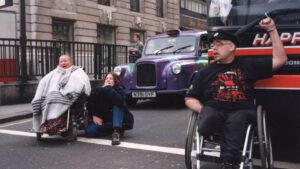
Translating these ideas back to ‘CRIP ARTE SPAZIO’ in Venice, it felt right to bring the feeling of being in a bustling urban plaza to the exhibition space, to embrace the rawness and grandeur of the architecture to create a public space where the cacophony the many crip artist-activists can be celebrated and heard.
There were many other influences, too – such as El Lissitzky’s design of the Soviet Pavilion in Cologne as a total experience; DIY protest banners and textiles; other folk aesthetics such as those from village carnivals.
‘What we did was to try to create a new kind of ‘CRIP’ aesthetic – what do we mean by that?’
The initial designs were about problem-solving, whilst not losing the exhilaration of the DAM. At the same time, I was introduced to the idea of ‘propaganda aesthetics’ by activist-curator, David Hevey. These concepts gradually evolved into a set of principles that became defining features of the exhibition:
‘What’s In A Name – we spelt out the show’s attitude in the title: CRIP ARTE SPAZIO: THE DAM IN VENICE’
The core of the show is the message (what we want the audience to know) and that message is omnipresent and manifests itself in multiples and in different styles and forms: from beautifully design typography, to window vinyls, lettered doors, bespoke banners, table legs, texts in films, exhibition guides, so on and so forth – the core messages are infused in everything you see and touch, and they are always spelt out clearly so you cannot miss it. The designs for each element of the show were carefully thought-through so the medium fuse with the message.
‘the visceral always comes before the cerebral’
The visceral part of the show (what we want the audience to feel – that the DAM was a glorious, energising, uplifting and creative process, as well as the fact that big ambitions can be achieved by people with the least ‘power’ and you can do it – attitude) – to do this I wanted to activate the audiences by capitalising on what the existing architecture allows you to do, so that you look up to the crips in power, and that you can walk on and touch some of the work, so creating dynamic perspectives.
‘Playing with dialectics’
Similar to the dialectics being played between the grandeur of the architecture and the intimacy of the artworks, we also mixed-up the high-tech and lo-fi aesthetics, digital and the tactile – the minimalist coolness audio and visual elements sit alongside the hand-made objects, some are exquisite and others slightly distressed and un-polished – they all have a specificity and a place in the show.
‘Expanding myself as a multi-skilled curator and creative practitioner’
The complexity and ambition of this exhibition, and the pressure of making it a success in Venice was a real test of my abilities. It was also a wonderful opportunity for me to bring to the project many different skills that I’ve developed over the years, beyond that of being an arts curator. Encouraged by the activist-curator, David Hevey and having had the opportunity to learn new skills with my Arts Council England’s Developing Your Creative Practice grant, I started my journey in DAM as a curatorial consultant, then to become the Exhibition Designer, where I created the designs for and sometimes fabricated all the new elements to the exhibition, including the large series of fabric banners. I also worked on the series of artist films directed by David Hevey, being part of a professional film crew as second camera and location sound recordist, of footage of which I then edited as an installation film for the exhibition in Venice.
Putting together the production crew was also a high-wired act – David and I deliberately decided against using a single contractor but assembled a motley crew of talented individuals who worked outside mainstream arts production, many of whom had never done anything like this before, myself included! So there was a lot of pressure to get it right. In the following posts, I will be sharing in more detail the various elements of the show and how we all made it happen!
Written by Nina Shen (July 2024, Folkestone)
Gallery Images: [1, 3, 4] Photographs by Andy Barker
Gallery Image [2] Courtesy of NDMAC’s Keith Armstrong Photographic Archive
CRIP ARTE SPAZIO – THE DAM IN VENICE is a landmark exhibition showcasing the UK Disability Arts Movement on the International stage.
Curated by David Hevey, designed by Nina Shen at CT20, produced by Shape Arts and installed by an outstanding crew based in Folkestone, the exhibition opens to the public from Apr – Nov 2024, at CREA (Venice International Cultural Centre) based in a living dockyard on the island of Giudecca, in Venice.
The project is generously funded by Arts Council England and the National Lottery Heritage Fund.
Nina Shen is the founder and creative director at CT20. She is a multi-disciplinary artist, arts curator and producer who leads all creative content-making in the organisation.
With a background in architecture and design, Nina is often invited to design highly ambitious and radical exhibitions and installation projects for other cultural organisations, such as Shape Arts and NDMAC.
We would like to thank Shape Arts and NDAMC for the incredibly opportunity to be part of the project.

